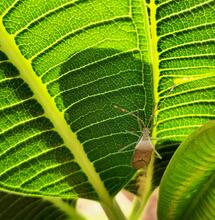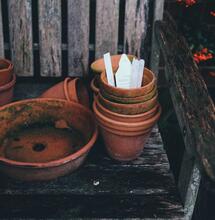Far-Red Lamps

In the summer of 2015, I decided to design an experiment with a few far-red lamps I had been waiting to use. The purpose of this experiment was to test and record the changes, if any, of adding far-red lamps to a controlled indoor grow. I hoped the far-red light would induce early flowering in the few plants placed directly under the added light.
In the summer of 2015, I decided to design an experiment with a few far-red lamps I had been waiting to use. The purpose of this experiment was to test and record the changes, if any, of adding far-red lamps to a controlled indoor grow. I hoped the far-red light would induce early flowering in the few plants placed directly under the added light.
In the summer of 2015, I decided to design an experiment with a few far-red lamps I had been waiting to use. The purpose of this experiment was to test and record the changes, if any, of adding far-red lamps to a controlled indoor grow. I hoped the far-red light would induce early flowering in the few plants placed directly under the added light.
I decided to test my theory, so in late June I placed four 730 nm (far-red) lamps over several plants to see whether I could induce early flowering by turning them on at dusk. I set up a group of controls to test my theory. The controls were exposed to natural light during the day but not the far-red lamps at day’s end. First, I planned my experimental garden.
I set the plants up in a homemade deep-water culture system, where they grew well. A 9.525 mm braided nylon rope was used as the wick to draw water from the bottom of the container. Then the water was wicked up through the planting mix as the roots removed it. About a week later, July 1, the nutrient mix was changed from vegetative to flowering formula and the EC was kept at 550-600 ppm and the pH at about 6.
Water and nutrients were added as needed to maintain those levels. During the summer months, the trays needed additional water and nutrients about twice a week. However, the system could have also been automated with the addition of a float valve attached to a reservoir, such as a large bucket that is installed above the water level. An induction fluorescent was mounted on a sidewall that delivered light only to the middle of the garden. The plants close to either the front or rear door received no light from the fixture.
These plants were my experimental “controls”. By early August the experimental plants had been under the influence of the far-red lamps for more than five weeks. The results were unexpected. The far-red light did not speed up flowering time. I still think the theory is valid, but I don’t think these lamps delivered enough intensity to trigger the phytochrome reaction I was looking for.
However, without realizing it, I had inadvertently set up another experiment. By placing a 300-watt induction fluorescent in the middle of the experimental area so that some of the plants received five hours of extra illumination during the lighted times, but were still shaded parts of the day. None of these plants received the far-red light treatment. There was also a third group of plants that could also be considered a control. They were on the other side of the fluorescents, opposite the far-red light treatment and received neither far-red nor extra light.
The result was that the flowers on the plants receiving the supplemental fluorescent light were more developed by 7-10 days at the end of five weeks than either the ones receiving the far-red light or no supplemental lighting. The control, which received no supplemental lighting and the far-red light treated plants, both showed the same slower flower development.
This indicates that less intense light slows flower development and ripening. This is in addition to reducing yield and quality. Expect plants grown in shade or under cloud cover to yield less in more time. However, you can improve yield and shorten ripening time with nominal supplemental light. By the first week in September, a month later, the plants showed marked differences based on their placement, rather than on variety. The buds closest to the bulb and in direct contact with sunlight were the first to ripen. Buds on the same plant that received less light were a few days behind, but the side plants, which received no supplemental light, were two weeks or more from ripening.
This outcome is consistent with other studies regarding daily light integral (DLI). It represents the total amount of light usable by the plant over a 24-hour period. The theory is that growth and maturity is dependent upon the amount of light the plant receives. In this experiment, neither the enriched light plants nor the controls were receiving the maximum light they could process, but the enriched light plants were receiving considerably more than the controls. Therefore, any difference in growth or maturity, not variety related would be attributed to the increase in light of the experimental group.
The result was that the experimental group did grow larger and mature faster than the control group. The result of this experiment has practical applications: supplementing natural light with additional intensity from electrical sources increases the yield while shortening ripening time. The light can be used to supplement the whole garden in the fall, when natural light intensity is diminishing day by day. Increasing light to the shaded part of the garden, especially when the plants are maturing, is even more beneficial. Supplementing the natural light with light from induction fluorescents, white LEDs or metal halides adds brightness, but is usually not noticeable to casual passerby since all of their spectrums are close to natural light.
The plants under the light were harvested September 3. The controls were harvested 12 days later—but by that time the weather had changed. Oakland, a coastal city in California, experiences high humidity. With the temperature dropping at night to 13° C and the plants spending a large part of the time in the 13 - 21° C range, it was almost inevitable the plants would be attacked by powdery mildew (PM).
We tried controlling it using a 10% milk solution and herbal fungicides, but the attack was overwhelming. The second part of the harvest was not worth our collection efforts because of the looser buds resulting from late September’s lower light levels and widespread attacks of powdery mildew. So, the use of supplemental light resulted in higher yields of the light enriched plants, and also decreased ripening time, saving the crop from the onslaughts of fall weather.
The uncut plants were hung in an unheated room for about three weeks. The temperature in the space stayed in the cool range of about 15-21° C. The buds dried but retained some pliability; perfect for smoking—not over-dried to stale and crisp. A friend then manicured the four plants.
The two Jack hybrids weighed 68 grams and 87 grams respectively. Two unknown hybrids weighed 80 grams and 53 grams, respectively, a total of 288 grams. All the buds were moderate size but tight and fully loaded with trichomes.
The buds were placed in clean glass jars and will be stored in a refrigerator at about 7° C, which will keep them fresh. Since the phytochrome far-red light experiment is completed with negative results I am removing the lights from the room. I plan to install more lights that will go on during the day, during the time the plants are in shade. I anticipate that this will increase yield and speed growth and ripening. I will leave control plants without supplemental lighting to see the difference.



.png)